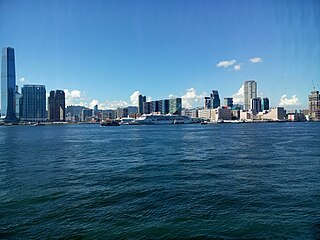
Hong Kong, officially the Hong Kong Special Administrative Region of the People's Republic of China (HKSAR), is a city and special administrative region of China on the eastern Pearl River Delta in South China. With over 7.5 million residents of various nationalities in a 1,104-square-kilometre (426 sq mi) territory, Hong Kong is one of the most densely populated places in the world. Hong Kong is also one of the most developed cities in the world.

Hong Kong Special Administrative Region of China of the People's Republic of China (HKSAR), can be geographically divided into three territories: Kowloon, Hong Kong Island, and the New Territories. Hong Kong is a coastal city and major port in Southern China, bordering Guangdong province through the city of Shenzhen to the north and the South China Sea to the west, east and south. Hong Kong and its 260 territorial islands and peninsulas are located at the mouth of the Pearl River Delta. The area of Hong Kong is distinct from Mainland China, but is considered part of "Greater China".

Lamma Island, also known as Y Island or Pok Liu Chau or simply Pok Liu, is the third largest island in Hong Kong. Administratively, it is part of the Islands District.

Kowloon is an urban area in Hong Kong comprising the Kowloon Peninsula and New Kowloon. With a population of 2,019,533 and a population density of 43,033/km2 in 2006, it is the most populous urban area in Hong Kong. The peninsula's area is about 47 km2 (18 sq mi).

Central is the central business district of Hong Kong. It is located in Central and Western District, on the north shore of Hong Kong Island, across Victoria Harbour from Tsim Sha Tsui, the southernmost point of Kowloon Peninsula. The area was the heart of Victoria City, although that name is rarely used today.

The New Territories is one of the three main regions of Hong Kong, alongside Hong Kong Island and the Kowloon Peninsula. It makes up 86.2% of Hong Kong's territory, and contains around half of the population of Hong Kong. Historically, it is the region described in the Convention for the Extension of Hong Kong Territory. According to that treaty, the territories comprise the mainland area north of Boundary Street on the Kowloon Peninsula and south of the Sham Chun River, as well as over 200 outlying islands, including Lantau Island, Lamma Island, Cheung Chau, and Peng Chau in the territory of HK.

Victoria Peak is a hill on the western half of Hong Kong Island. It is also known as Mount Austin, and locally as The Peak. With an elevation of 552 metres (1,811 ft), it is the highest hill on Hong Kong Island, ranked 29 in terms of elevation in Hong Kong. It is a major tourist attraction offering views of Central, Victoria Harbour, Lamma Island and the surrounding islands.

The Hong Kong–Zhuhai–Macau Bridge (HZMB) is a 55-kilometre (34 mi) bridge–tunnel system consisting of a series of three cable-stayed bridges, an undersea tunnel, and four artificial islands. It is both the longest sea crossing and the longest open-sea fixed link in the world. The HZMB spans the Lingding and Jiuzhou channels, connecting Hong Kong, Macau, and Zhuhai—three major cities on the Pearl River Delta.

Chek Lap Kok is an island in the western waters of Hong Kong's New Territories. Unlike the smaller Lam Chau, it was only partially leveled when it was assimilated via land reclamation into the 12.48 square kilometres (4.82 sq mi) island for the current Hong Kong International Airport, which opened for commercial aviation in 1998. The airport is popularly referred to as Chek Lap Kok Airport to distinguish it from the former Hong Kong International Airport, now commonly known as Kai Tak Airport (啟德機場).

Cantonese is a language within the Chinese (Sinitic) branch of the Sino-Tibetan languages originating from the city of Guangzhou and its surrounding area in Southeastern China. It is the traditional prestige variety of the Yue Chinese dialect group, which has over 80 million native speakers. While the term Cantonese specifically refers to the prestige variety, it is often used to refer to the entire Yue subgroup of Chinese, including related but largely mutually unintelligible languages and dialects such as Taishanese.
The Mercantile Bank of India, London and China, later Mercantile Bank Ltd, was an Anglo-Indian bank with business focus in the Far East. It was founded in Bombay in 1853 as the Mercantile Bank of Bombay; and later in 1857 was renamed to Mercantile Bank of India, London, and China with London as its headquarters.

Hong Kong Cantonese is a dialect of the Cantonese language of the Sino-Tibetan family. It is the native and de facto standard language of Hong Kong, one of the two special administrative regions of the People's Republic of China. A similar dialect is also spoken in Macau.

Hong Kong House, also known since 1995 as the Hong Kong Economic and Trade Office, Sydney, is a landmark heritage building and former hotel in the Sydney central business district, City of Sydney, New South Wales, Australia. Built in 1891 to a design by Ambrose Thornley, it is located on 80 Druitt Street, at the corner with York Street, and is adjacent to other prominent heritage landmarks, the Sydney Town Hall and the Queen Victoria Building. Formerly known as Gresham Hotel, the property was added to the New South Wales State Heritage Register on 2 April 1999.

Bao'an County, formerly named Xin'an County, was a historical county in South China. It roughly follows the administrative boundaries of modern-day Hong Kong and the city of Shenzhen. For most of its history, the administrative center of the county was in Nantou.

The following outline is provided as an overview of and topical guide to Hong Kong:

Hongkongers, also known as Hong Kongers, Hong Kongese, Hongkongese, Hong Kong citizen and Hong Kong people, typically refers to legal residents of the city of Hong Kong; although may also refer to others who were born and/or raised in the city.
Greater Bay Airlines Limited, is a Hong Kong-based airline established as Donghai Airlines in 2010, and rebranded in July 2020. To date, the company has completed one charter flight from Hong Kong to Bangkok.












